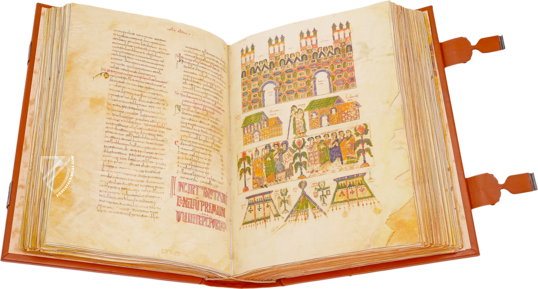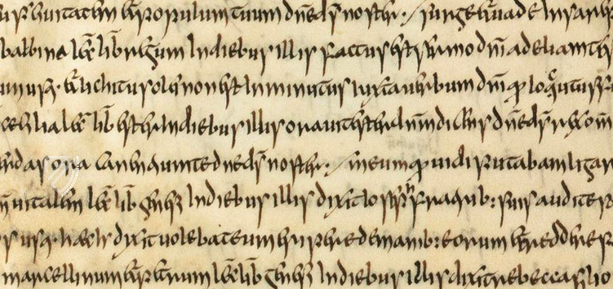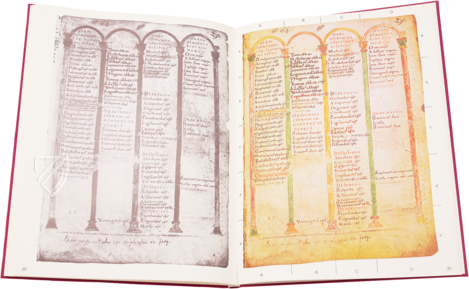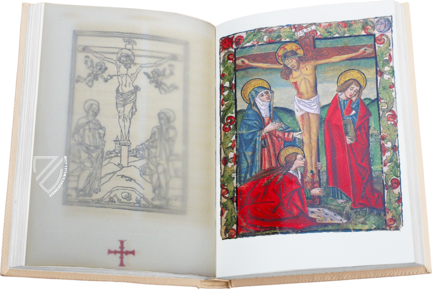Codex Trecensis - Pastoral Rule of Gregory the Great
(under 1,000€)
Dating from ca. 600, this manuscript contains the oldest known version of Pope Gregory the Great ‘s Liber Regulae Pastoralis or The Book of the Pastoral Rule, commonly known in English as Pastoral Care. It was originally written by the sainted pontiff ca. 590, shortly after his papal election, and was later revised by him. Pastoral Care became one of the most influential works concerning the responsibilities of the clergy that was ever written and was widely distributed – the book was translated into Greek at the behest of the Eastern Roman Emperor Maurice and was translated into Anglo-Saxon by King Alfred the Great himself. The oldest surviving manuscript containing the full revised text was written in uncial script without breaks between words and is adorned by initials in red, green, and yellow.
Codex Trecensis – Pastoral Rule of Gregory the Great
Counted among the most important figures in the development of Christianity, Pope Gregory I (ca. 540–604) was a more prolific author than any pope to have come before him and wrote one of the most influential and widely celebrated works concerning the priesthood and its responsibilities. Although highly praised, many contemporaries felt Gregory set the bar too high in terms of the personal, intellectual, and moral standards he expected from the common parish priest. Nonetheless, the Liber Regulae Pastoralis was quickly disseminated from the Eastern Mediterranean to the British Isles. Originally, the text was written by Gregory as a response to a query by Bishop John of Ravenna. The commonly used title is derived from a letter written by Gregory when he sent a copy to his friend Saint Leander of Seville (ca. 534–600/601).
A Vastly Influential Work
In contrast to the typical image of the so-called “Dark Ages”, there was actually a network of monasteries and scriptoria that allowed the Regulae to be copied and spread to virtually every corner of Christendom within 10 years of Gregory writing it. After personally reading a copy, the Byzantine Emperor Maurice (539-602) ordered that the work be translated into Greek and had copies sent to every bishop in the Empire. Gregory’s work stands alone among the Latin works of the period deemed worthy enough to be translated into Greek. It was equally popular in the West and was brought to the Anglo-Saxon Kingdom of Kent by Augustine (d. 604), the first Archbishop of Canterbury, in 597 as part of a mission commissioned by Gregory. As part of a project to improve education in Anglo-Saxon England, King Alfred the Great (848/849–899) personally translated the work into Old English and described both his methods and rationale behind the project in a preface. The work appears to have been adopted by the bishops of the Frankish Empire after a series of councils in 813 and continued to be regarded as the most essential guide for priests across Europe for centuries to come.
Created in Gregory’s Lifetime
Among the numerous copies of Pastoral Care that survive today, the oldest is believed to be a manuscript originating from Rome ca. 600 when Gregory was still pope and is stored today in the Troyes Public Library under the shelf mark MS 504. Not only does it contain the full revised text, but it is also one of the oldest complete manuscripts in existence. It was written in an unbroken uncial script, about 25 lines per page, which is adorned with red, green, and yellow initials. The initials exhibit characteristics from Insular illumination and are similar to the opening initial of the so-called Bobbio Jerome, which was created by Hiberno-Scottish monks in Northern Italy about 20 years earlier. Although the first three lines written in red ink have faded, the black ink remains clearly legible. The manuscript is a precious relic not only of Christian theology but of the manuscript tradition at the end of Late Antiquity.
Saint Gregory the Great
Gregory was the son of a Roman senator and served as prefect of Rome at the age of 30. He also lived for years in a monastery for years and became the first pope from a monastic background. This combination of a proper theological education and experience with politics and as an administrator made for an exceptional pope who expanded the authority of the papacy to Spain and France, send missionaries to England, and convinced the Franks, Lombards, and Visigoths to abandon Arian Christianity in favor of Rome’s teachings. Known throughout the Middle Ages as “the Father of Christian Worship”, today he is regarded as a saint in Catholicism, Eastern Orthodoxy, as well as many Protestant denominations and is counted as one of the Latin Fathers and a Doctor of the Church. Gregory is the patron saint of musicians, singers, students, and teachers. Even John Calvin (1509–64), who did not believe in the veneration of saints, declared Gregory to be the last good pope.
Codicology
- Alternative Titles
- Codex Trecensis - Pastoralregel von Gregor dem Großen
Codex Trecensis
La Regola pastorale di Gregorio Magno
La Règle pastorale de Grégoire le GrandCodex trecensis
Liber pastoralis S. Gregorii papa - Size / Format
- 312 pages / 28.9 × 22.0 cm
- Origin
- Italy
- Date
- About 600
- Epochs
- Style
- Language
- Script
- Uncial
- Artist / School
- Pope Gregory I (r. 590–604) (author)
#1 Codex Trecensis: la "Regola Pastorale" di Gregorio Magno
Languages: French, Italian, Latin
(under 1,000€)
- Treatises / Secular Books
- Apocalypses / Beatus
- Astronomy / Astrology
- Bestiaries
- Bibles / Gospels
- Chronicles / History / Law
- Geography / Maps
- Saints' Lives
- Islam / Oriental
- Judaism / Hebrew
- Single Leaf Collections
- Leonardo da Vinci
- Literature / Poetry
- Liturgical Manuscripts
- Medicine / Botany / Alchemy
- Music
- Mythology / Prophecies
- Psalters
- Other Religious Books
- Games / Hunting
- Private Devotion Books
- Other Genres
- Afghanistan
- Armenia
- Austria
- Belgium
- Belize
- Bosnia and Herzegovina
- China
- Colombia
- Costa Rica
- Croatia
- Cyprus
- Czech Republic
- Denmark
- Egypt
- El Salvador
- Ethiopia
- France
- Germany
- Greece
- Guatemala
- Honduras
- Hungary
- India
- Iran
- Iraq
- Israel
- Italy
- Japan
- Jordan
- Kazakhstan
- Kyrgyzstan
- Lebanon
- Liechtenstein
- Luxembourg
- Mexico
- Morocco
- Netherlands
- Palestine
- Panama
- Peru
- Poland
- Portugal
- Romania
- Russia
- Serbia
- Spain
- Sri Lanka
- Sweden
- Switzerland
- Syria
- Tajikistan
- Turkey
- Turkmenistan
- Ukraine
- United Kingdom
- United States
- Uzbekistan
- Vatican City
- A. Oosthoek, van Holkema & Warendorf
- Aboca Museum
- Ajuntament de Valencia
- Akademie Verlag
- Akademische Druck- u. Verlagsanstalt (ADEVA)
- Aldo Ausilio Editore - Bottega d’Erasmo
- Alecto Historical Editions
- Alkuin Verlag
- Almqvist & Wiksell
- Amilcare Pizzi
- Andreas & Andreas Verlagsbuchhandlung
- Archa 90
- Archiv Verlag
- Archivi Edizioni
- Arnold Verlag
- ARS
- Ars Magna
- ArtCodex
- AyN Ediciones
- Azimuth Editions
- Badenia Verlag
- Bärenreiter-Verlag
- Belser Verlag
- Belser Verlag / WK Wertkontor
- Benziger Verlag
- Bernardinum Wydawnictwo
- BiblioGemma
- Biblioteca Apostolica Vaticana (Vaticanstadt, Vaticanstadt)
- Bibliotheca Palatina Faksimile Verlag
- Bibliotheca Rara
- Boydell & Brewer
- Bramante Edizioni
- Bredius Genootschap
- Brepols Publishers
- British Library
- C. Weckesser
- Caixa Catalunya
- Canesi
- CAPSA, Ars Scriptoria
- Caratzas Brothers, Publishers
- Carus Verlag
- Casamassima Libri
- Centrum Cartographie Verlag GmbH
- Chavane Verlag
- Christian Brandstätter Verlag
- Circulo Cientifico
- Club Bibliófilo Versol
- Club du Livre
- CM Editores
- Collegium Graphicum
- Collezione Apocrifa Da Vinci
- Comissão Nacional para as Comemorações dos Descobrimentos Portugueses
- Coron Verlag
- Corvina
- CTHS
- D. S. Brewer
- Damon
- De Agostini/UTET
- De Nederlandsche Boekhandel
- De Schutter
- Deuschle & Stemmle
- Deutscher Verlag für Kunstwissenschaft
- DIAMM
- Droz
- E. Schreiber Graphische Kunstanstalten
- Ediciones Boreal
- Ediciones Grial
- Ediclube
- Edições Inapa
- Edilan
- Editalia
- Edition Deuschle
- Edition Georg Popp
- Edition Leipzig
- Edition Libri Illustri
- Editiones Reales Sitios S. L.
- Éditions de l'Oiseau Lyre
- Editions Medicina Rara
- Editorial Casariego
- Editorial Mintzoa
- Editrice Antenore
- Editrice Velar
- Edizioni Edison
- Egeria, S.L.
- Eikon Editores
- Electa
- Emery Walker Limited
- Enciclopèdia Catalana
- Eos-Verlag
- Ephesus Publishing
- Ernst Battenberg
- Eugrammia Press
- Extraordinary Editions
- Fackelverlag
- Facsimila Art & Edition
- Facsimile Editions Ltd.
- Facsimilia Art & Edition Ebert KG
- Faksimile Verlag
- Feuermann Verlag
- Folger Shakespeare Library
- Franco Cosimo Panini Editore
- Friedrich Wittig Verlag
- Fundación Hullera Vasco-Leonesa
- G. Braziller
- Gabriele Mazzotta Editore
- Gebr. Mann Verlag
- Gesellschaft für graphische Industrie
- Getty Research Institute
- Giovanni Domenico de Rossi
- Giunti Editore
- Graffiti
- Grafica European Center of Fine Arts
- Guido Pressler
- Guillermo Blazquez
- Gustav Kiepenheuer
- H. N. Abrams
- Harrassowitz
- Harvard University Press
- Helikon
- Hendrickson Publishers
- Henning Oppermann
- Herder Verlag
- Hes & De Graaf Publishers
- Hoepli
- Holbein-Verlag
- Houghton Library
- Hugo Schmidt Verlag
- Idion Verlag
- Il Bulino, edizioni d'arte
- ILte
- Imago
- Insel Verlag
- Insel-Verlag Anton Kippenberger
- Instituto de Estudios Altoaragoneses
- Instituto Nacional de Antropología e Historia
- Introligatornia Budnik Jerzy
- Istituto dell'Enciclopedia Italiana - Treccani
- Istituto Ellenico di Studi Bizantini e Postbizantini
- Istituto Geografico De Agostini
- Istituto Poligrafico e Zecca dello Stato
- Italarte Art Establishments
- Jan Thorbecke Verlag
- Johnson Reprint Corporation
- Josef Stocker
- Josef Stocker-Schmid
- Jugoslavija
- Karl W. Hiersemann
- Kasper Straube
- Kaydeda Ediciones
- Kindler Verlag / Coron Verlag
- Kodansha International Ltd.
- Konrad Kölbl Verlag
- Kurt Wolff Verlag
- La Liberia dello Stato
- La Linea Editrice
- La Meta Editore
- Lambert Schneider
- Landeskreditbank Baden-Württemberg
- Leo S. Olschki
- Les Incunables
- Liber Artis
- Library of Congress
- Libreria Musicale Italiana
- Lichtdruck
- Lito Immagine Editore
- Lumen Artis
- Lund Humphries
- M. Moleiro Editor
- Maison des Sciences de l'homme et de la société de Poitiers
- Manuscriptum
- Martinus Nijhoff
- Maruzen-Yushodo Co. Ltd.
- MASA
- Massada Publishers
- McGraw-Hill
- Metropolitan Museum of Art
- Militos
- Millennium Liber
- Müller & Schindler
- Nahar - Stavit
- Nahar and Steimatzky
- National Library of Wales
- Neri Pozza
- Nova Charta
- Oceanum Verlag
- Odeon
- Orbis Mediaevalis
- Orbis Pictus
- Österreichische Staatsdruckerei
- Oxford University Press
- Pageant Books
- Parzellers Buchverlag
- Patrimonio Ediciones
- Pattloch Verlag
- PIAF
- Pieper Verlag
- Plon-Nourrit et cie
- Poligrafiche Bolis
- Presses Universitaires de Strasbourg
- Prestel Verlag
- Princeton University Press
- Prisma Verlag
- Priuli & Verlucca, editori
- Pro Sport Verlag
- Propyläen Verlag
- Pytheas Books
- Quaternio Verlag Luzern
- Reales Sitios
- Recht-Verlag
- Reichert Verlag
- Reichsdruckerei
- Reprint Verlag
- Riehn & Reusch
- Roberto Vattori Editore
- Rosenkilde and Bagger
- Roxburghe Club
- Salerno Editrice
- Saltellus Press
- Sandoz
- Sarajevo Svjetlost
- Schöck ArtPrint Kft.
- Schulsinger Brothers
- Scolar Press
- Scrinium
- Scripta Maneant
- Scriptorium
- Shazar
- Siloé, arte y bibliofilia
- SISMEL - Edizioni del Galluzzo
- Sociedad Mexicana de Antropología
- Société des Bibliophiles & Iconophiles de Belgique
- Soncin Publishing
- Sorli Ediciones
- Stainer and Bell
- Studer
- Styria Verlag
- Sumptibus Pragopress
- Szegedi Tudomànyegyetem
- Taberna Libraria
- Tarshish Books
- Taschen
- Tempus Libri
- Testimonio Compañía Editorial
- Thames and Hudson
- The Clear Vue Publishing Partnership Limited
- The Facsimile Codex
- The Folio Society
- The Marquess of Normanby
- The Richard III and Yorkist History Trust
- Tip.Le.Co
- TouchArt
- TREC Publishing House
- TRI Publishing Co.
- Trident Editore
- Tuliba Collection
- Typis Regiae Officinae Polygraphicae
- Union Verlag Berlin
- Universidad de Granada
- University of California Press
- University of Chicago Press
- Urs Graf
- Vallecchi
- Van Wijnen
- VCH, Acta Humaniora
- VDI Verlag
- VEB Deutscher Verlag für Musik
- Verlag Anton Pustet / Andreas Verlag
- Verlag Bibliophile Drucke Josef Stocker
- Verlag der Münchner Drucke
- Verlag für Regionalgeschichte
- Verlag Styria
- Vicent Garcia Editores
- W. Turnowski Ltd.
- W. Turnowsky
- Waanders Printers
- Wiener Mechitharisten-Congregation (Wien, Österreich)
- Wissenschaftliche Buchgesellschaft
- Wissenschaftliche Verlagsgesellschaft
- Wydawnictwo Dolnoslaskie
- Xuntanza Editorial
- Zakład Narodowy
- Zollikofer AG









